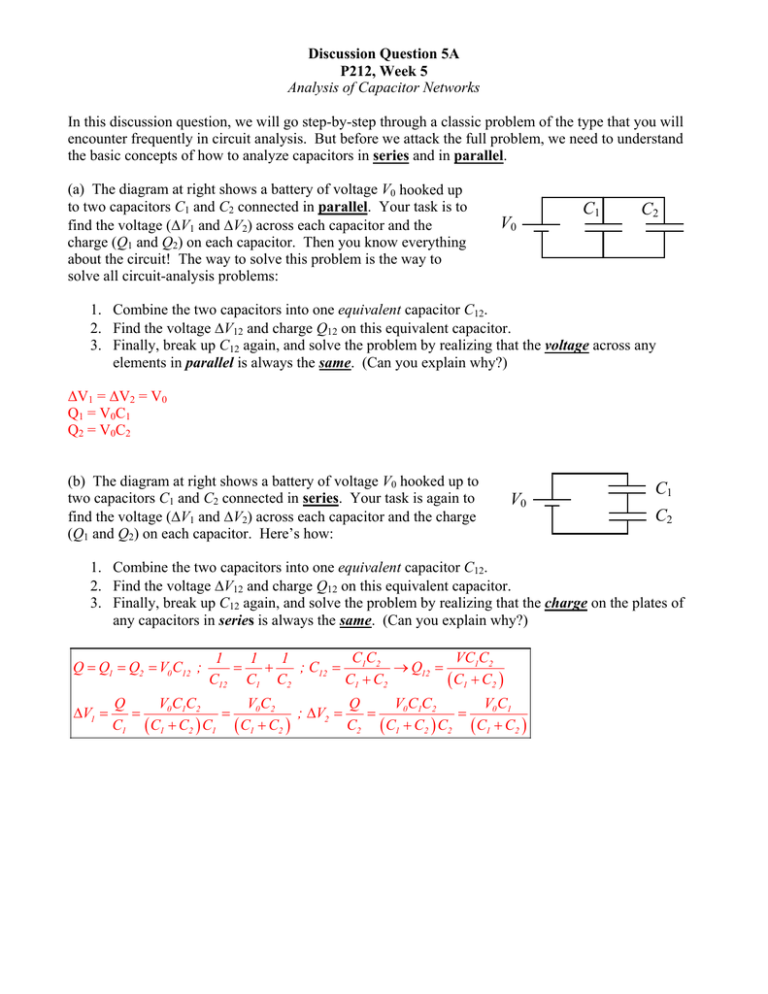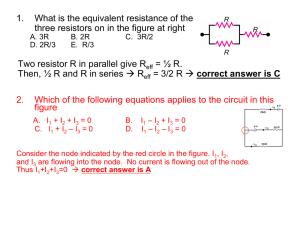Discussion Question 5A
advertisement

Discussion Question 5A P212, Week 5 Analysis of Capacitor Networks In this discussion question, we will go step-by-step through a classic problem of the type that you will encounter frequently in circuit analysis. But before we attack the full problem, we need to understand the basic concepts of how to analyze capacitors in series and in parallel. (a) The diagram at right shows a battery of voltage V0 hooked up to two capacitors C1 and C2 connected in parallel. Your task is to find the voltage (ΔV1 and ΔV2) across each capacitor and the charge (Q1 and Q2) on each capacitor. Then you know everything about the circuit! The way to solve this problem is the way to solve all circuit-analysis problems: V0 C1 C2 1. Combine the two capacitors into one equivalent capacitor C12. 2. Find the voltage ΔV12 and charge Q12 on this equivalent capacitor. 3. Finally, break up C12 again, and solve the problem by realizing that the voltage across any elements in parallel is always the same. (Can you explain why?) ΔV1 = ΔV2 = V0 Q1 = V0C1 Q2 = V0C2 (b) The diagram at right shows a battery of voltage V0 hooked up to two capacitors C1 and C2 connected in series. Your task is again to find the voltage (ΔV1 and ΔV2) across each capacitor and the charge (Q1 and Q2) on each capacitor. Here’s how: V0 C1 C2 1. Combine the two capacitors into one equivalent capacitor C12. 2. Find the voltage ΔV12 and charge Q12 on this equivalent capacitor. 3. Finally, break up C12 again, and solve the problem by realizing that the charge on the plates of any capacitors in series is always the same. (Can you explain why?) Q = Q1 = Q2 = V0 C12 ; ΔV1 = CC VC1C2 1 1 1 = + ; C12 = 1 2 → Q12 = C12 C1 C2 C1 + C2 ( C1 + C2 ) V0 C1C2 V0 C2 V0 C1C2 V0 C1 Q Q = = ; ΔV2 = = = C1 ( C1 + C2 ) C1 ( C1 + C2 ) C2 ( C1 + C2 ) C2 ( C1 + C2 ) Now on to a more complex problem! A battery of voltage V0 is hooked up to a network of 5 capacitors, connected together as shown. You are asked three questions: C1 1. What is the voltage VA at the point A? 2. What is the voltage VB at the point B? A C2 V0 C4 B C5 C3 3. What is the charge Q5 on capacitor C5? V0 = 12 V C1 = 5 μF C2 = 8 μF C3 = 15 μF C4 = 3 μF C5 = 10 μF 4. What is the energy U1 stored on capacitor C1 ? For questions 1 and 2, you are asked for the voltage at particular points in the circuit. But “voltage relative to what”, you ask? Good question! It is traditional to consider the negative terminal of the battery as the zero of potential (i.e. as the reference point, or “ground”), and we will do so here. Although there are more steps involved, the circuit-analysis procedure here is the same as before: first collapse the capacitors down to one equivalent capacitance … then determine the voltage and charge on that “capacitor” … and finally break it up step-by-step, determining the voltage and charge on each component as you go. Let’s go through it in detail: (a) Collapse the circuit down to three equivalent capacitors C1, C23, and C45. (Be sure to draw your new equivalent circuit at each step → you’ll come back to it later!) C1 V0 C23 C45 C1 = C1 C23 = C2C3/(C2 + C3) = 5.22 μF C45 = C4 + C5 = 13 μF (b) Collapse the circuit further down to two equivalent capacitors C1 and C2345. C1 V0 C2345 C1 = C1 C2345 = C23 + C45 = 18.22 μF 2 (c) Finally, collapse the circuit down to one equivalent capacitor C. V0 C C = C1C2345/(C1 + C2345) = 3.92 μF (d) This you can solve! Determine the charge Q and voltage ΔV on this one capacitor. ΔV = V0 Q = CV0 = 47 μC (e) Now we’re ready for the second phase: breaking up our equivalent circuits, and solving for charges and voltages as we go. Using your answers to part (d), break up your 1-capacitor circuit into the 2capacitor version with C1 and C2345, and find the voltages ΔV1 and ΔV2345 and the charges Q1 and Q2345. ⇒ Once you’re done, you should have the answer to question 1: the voltage VA Q1 = Q2345 = Q = 47 μC ΔV1 = Q/ C1 = 9.42 V ΔV2345 = Q/ C2345 = 2.58 V VA = 12 - ΔV1 or ΔV2345 = 2.58 V (f) Break up the circuit further into the 3-capacitor version with C1, C23, and C45. Find the voltages ΔV23 and ΔV45 and the charges Q23 and Q45. ΔV23 = ΔV45 = ΔV2345 =2.58 V Q23 = C23ΔV23 =5.22 μF (2.58 V) =13.47 μC Q45 = C45ΔV45 =13 μF (2.58 V) = 33.54 μC (g) Finally, break up the circuit into its original 5-capacitor form. All you need now are the answers to the last two questions: the voltage VB and the charge Q5. Q2 = Q23 VB = ΔV3 = Q23 / C3 = 13.47 μC / 15 μF = 0.9 V Q5 = C5ΔV45 = 10 μF (2.58 V) = 25.8 μC For question 4: U1 = C1 (ΔV1)2 / 2 ≈ 221 μJ which (up to rounding errors) can also be obtained from U1 = Q12 / ( 2 C1 ) 3


